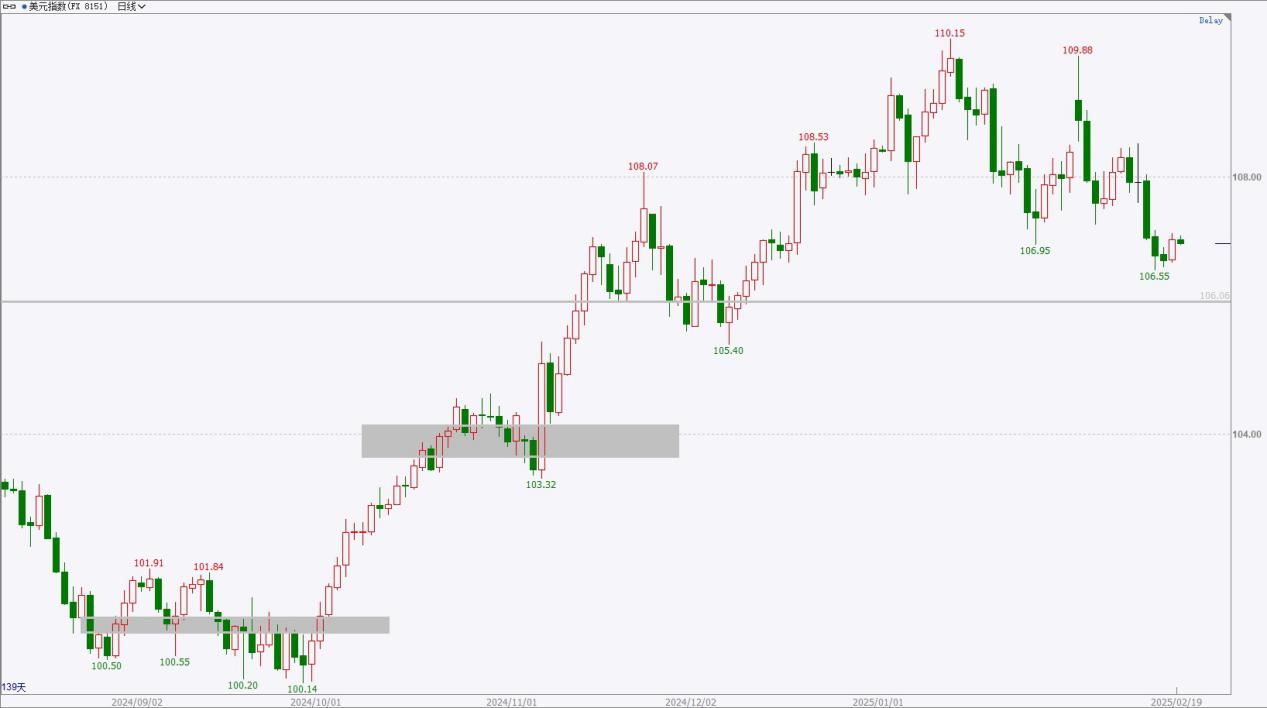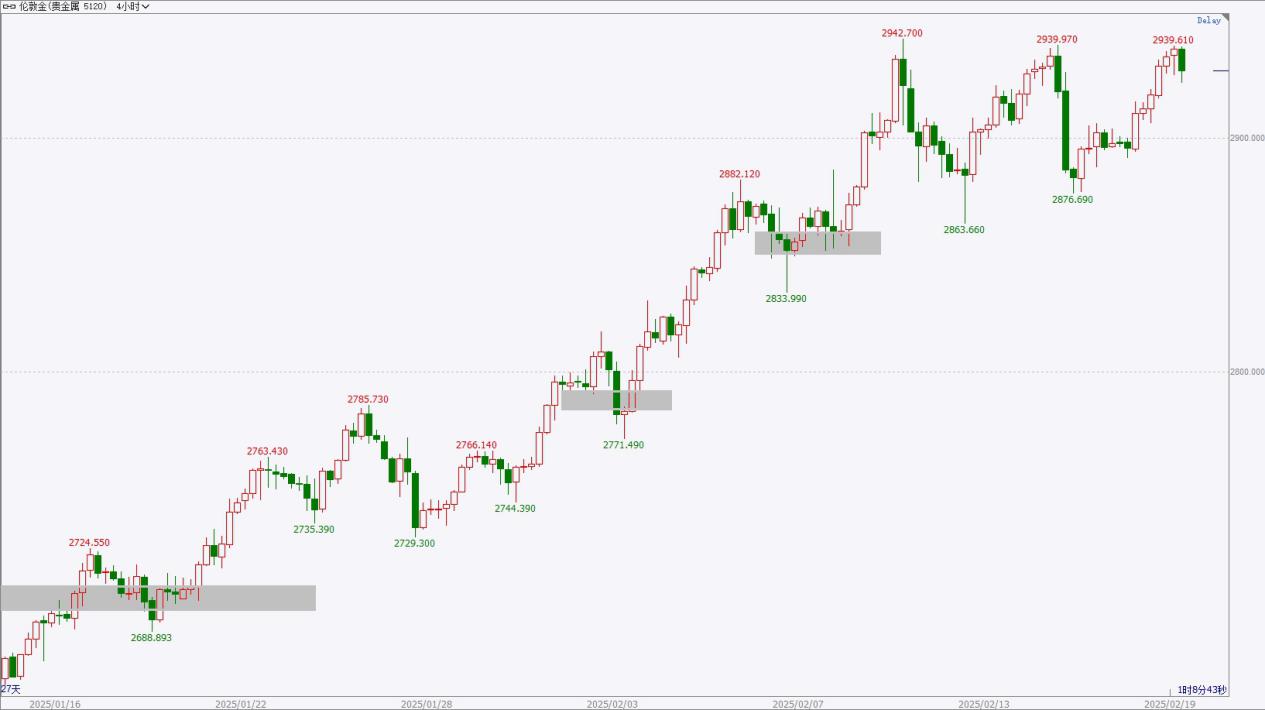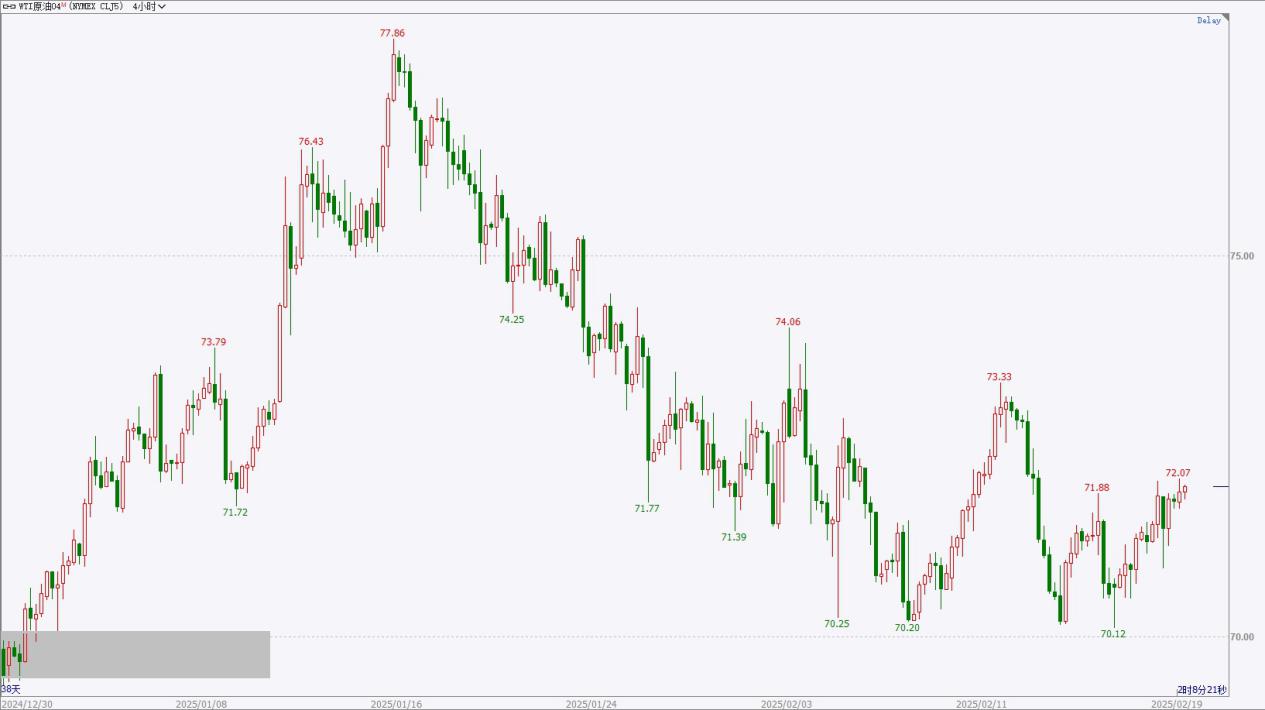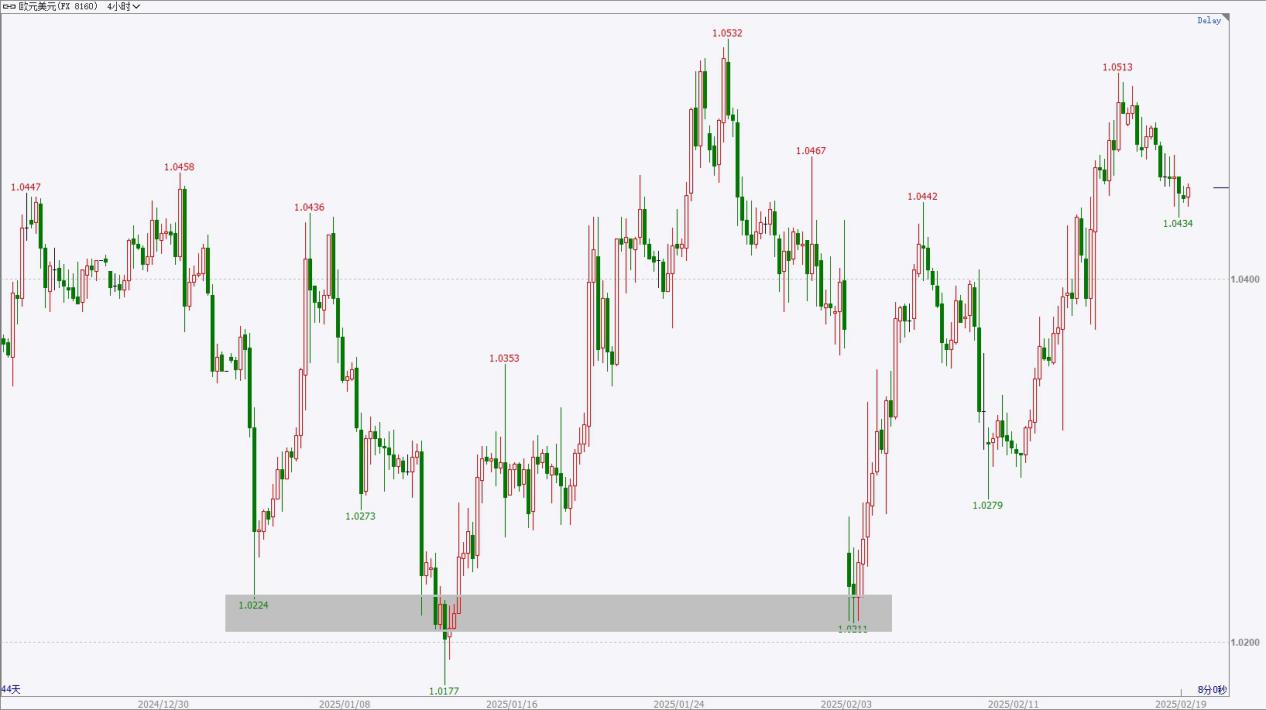|
Time
|
Data and Events
|
Importance
|
|
09:00
|
New Zealand’s decision on the interest rate as of February 19
|
★★★
|
|
10:00
|
Reserve Bank of New Zealand Governor Orr holds a monetary policy press conference
|
★★★
|
|
15:00
|
UK January CPI month-on-month
|
★★★
|
|
UK January Retail Price Index month-on-month
|
★★★
|
|
17:00
|
Eurozone December seasonally adjusted current account
|
★★★
|
|
21:30
|
US January new housing starts (annualized)
|
★★★
|
|
US January building permits total
|
★★★
|
|
Next day
03:00
|
The Federal Reserve releases the minutes of the January monetary policy meeting
|
★★★
|
|
Variety
|
Perspective
|
Support Range
|
Resistance Range
|
|
US Dollar Index
|
Weak fluctuations
|
105.5-106
|
108.5-109
|
|
Gold
|
Strong fluctuations
|
2850-2870
|
2980-3000
|
|
Oil
|
Short-term fluctuations
|
69-70
|
79-80
|
|
Euro
|
Strong fluctuations
|
1.0180-1.0200
|
1.0500-1.0550
|
*The pre-market perspective is time-sensitive and limited; it represents predictions and is for reference and learning purposes only, not constituting investment advice. Investment carries risks; trading requires caution.
Fundamental Analysis:
At the end of January, the Federal Reserve meeting maintained the interest rate unchanged, with a strong labor market, healthy economic expansion, and inflation still slightly elevated. The expectations for loose monetary policy have cooled, and attention will be paid to new government policies. January non-farm data showed new employment numbers decreased to 143,000, below expectations, while the unemployment rate slightly improved to 4.0%, indicating a stable labor market. January’s unadjusted CPI year-on-year recorded 3.0%, slightly higher than the previous value and expectations. The December core PCE price index was flat compared to its previous value; January’s ISM manufacturing PMI slightly increased.
Technical Analysis:

The US Dollar Index rebounded slightly yesterday, with moderate strength. The short-term trend shows volatility, with selling pressure above. Monitor the resistance structure above; if signs of resistance appear in the short term, consider opportunities for short selling. Overall, a strong tendency for large-scale fluctuations exists, but the short term is now entering a consolidation phase. The upper pressure area is around 108.5-109, while the support area below is around 105.5-106.
Perspective: weak fluctuations, short-term rebound; short positions may be attempted on rebound opportunities.
*The pre-market perspective is time-sensitive and limited; it represents predictions and is for reference and learning purposes only, not constituting investment advice. Investment carries risks; trading requires caution.
Fundamental Analysis:
The ongoing geopolitical conflict in the Middle East and instability in Eastern Europe create uncertainties. The European Central Bank’s decision at the end of January involved a fourth consecutive 25 basis points rate cut, while inflation remained generally in line with expectations, and the economy faced ongoing pressure. At the end of January, the Federal Reserve’s decision maintained rates unchanged, with good economic performance but elevated inflation levels, easing rate cut expectations. US January non-farm data showed average performance, with new employment numbers decreasing below expectations, while the unemployment rate slightly declined, performing better than expected; the January CPI year-on-year saw slight upward movement, slightly exceeding expectations.
Technical Analysis:

The gold price slightly rose during the night session but failed to significantly break through the previous high resistance level. In the short term, the market is moving sideways, with a relatively strong performance recently and no signs of weakening. The short-term trading strategy focuses on buying on dips and taking profits on highs. From a larger perspective, the upward structure remains intact, with daily oscillations moving upward and prices reaching new highs repeatedly. The upper resistance level may be around 2980-3000, while the lower support level is between 2850-2870.
Opinion: Trending stronger with a focus on short-term buying strategies, taking profits on highs.
*The pre-market perspective is time-sensitive and limited; it represents predictions and is for reference and learning purposes only, not constituting investment advice. Investment carries risks; trading requires caution.
Fundamental Analysis:
The February EIA monthly report maintains the global oil demand growth forecast for this and next year while slightly adjusting the oil price forecast for 2025. The OPEC monthly report also maintains the global oil demand growth forecast for this and next year. The IEA monthly report slightly raised the oil demand growth forecast for 2025. At the beginning of February, the OPEC+ meeting adhered to the previous oil production agreement, and the committee agreed to gradually increase oil production starting April 1, in line with prior plans. EIA crude oil inventories saw a significant increase, with recent data showing considerable volatility. Pay attention to the EIA crude oil inventory report on Friday morning.
Technical Analysis:

US crude oil slightly rose yesterday, with short-term oscillations trending upward. The price recently tested a key support area without effectively breaking down. Watch for stabilization signals, as short-term buying opportunities may arise. Overall, the crude oil price trends strongly with indications of stabilization at a larger scale, while it has entered a short-term correction. The upper resistance area is around 79-80, and the lower support area is 69-70.
Opinion: Short-term trends are oscillating, and the support area has not been breached. Look for stabilization signals to attempt buying on dips.
*The pre-market perspective is time-sensitive and limited; it represents predictions and is for reference and learning purposes only, not constituting investment advice. Investment carries risks; trading requires caution.
Fundamental Analysis:
At the end of January, the European Central Bank’s interest rate decision involved a 25 basis points cut for the fourth consecutive time. Inflation is generally in line with expectations and is expected to return to target levels this year, although the economy still faces challenges and may continue to be weak in the short term, supported by income and policy effects. At the end of January, the Fed’s interest rate decision maintained rates unchanged, with strong overall economic performance and reduced easing expectations. The US jobs report for January was average, with a decrease in new employment but a slight drop in the unemployment rate, which was slightly better than expected; the annual CPI for January showed a slight increase. Watch for the eurozone manufacturing PMI data on Friday.
Technical Analysis:

The euro price slightly fell yesterday, failing to break through the upper resistance level clearly. In the short term, it may test the area again, and stabilization signals should be monitored for potential buying opportunities on dips. Overall, prices are at a relatively low level, with a daily oscillation structure and no large-scale stabilization signals yet. The upper minor resistance area is around 1.0500-1.0550, while the lower support area is between 1.0180-1.0200.
Opinion: Trending stronger, monitor whether the pressure structure can break through, and wait for buying opportunities on dips.
*The pre-market perspective is time-sensitive and limited; it represents predictions and is for reference and learning purposes only, not constituting investment advice. Investment carries risks; trading requires caution.


Daily Reviews
Our award-winning team of analysts provides keen and insightful technical and fundamental analysis to understand daily market news and investment trading opportunities
HTFX Daily Forex Commentary 0219
Time
Data and Events
Importance
09:00
New Zealand’s decision on the interest rate as of February 19
★★★
10:00
Reserve Bank of New Zealand Governor Orr holds a monetary policy press conference
★★★
15:00
UK January CPI month-on-month
★★★
UK January Retail Price Index month-on-month
★★★
17:00
Eurozone December seasonally adjusted current account
★★★
21:30
US January new housing starts (annualized)
★★★
US January building permits total
★★★
Next day
03:00
The Federal Reserve releases the minutes of the January monetary policy meeting
★★★
Variety
Perspective
Support Range
Resistance Range
US Dollar Index
Weak fluctuations
105.5-106
108.5-109
Gold
Strong fluctuations
2850-2870
2980-3000
Oil
Short-term fluctuations
69-70
79-80
Euro
Strong fluctuations
1.0180-1.0200
1.0500-1.0550
*The pre-market perspective is time-sensitive and limited; it represents predictions and is for reference and learning purposes only, not constituting investment advice. Investment carries risks; trading requires caution.
Fundamental Analysis:
At the end of January, the Federal Reserve meeting maintained the interest rate unchanged, with a strong labor market, healthy economic expansion, and inflation still slightly elevated. The expectations for loose monetary policy have cooled, and attention will be paid to new government policies. January non-farm data showed new employment numbers decreased to 143,000, below expectations, while the unemployment rate slightly improved to 4.0%, indicating a stable labor market. January’s unadjusted CPI year-on-year recorded 3.0%, slightly higher than the previous value and expectations. The December core PCE price index was flat compared to its previous value; January’s ISM manufacturing PMI slightly increased.
Technical Analysis:
The US Dollar Index rebounded slightly yesterday, with moderate strength. The short-term trend shows volatility, with selling pressure above. Monitor the resistance structure above; if signs of resistance appear in the short term, consider opportunities for short selling. Overall, a strong tendency for large-scale fluctuations exists, but the short term is now entering a consolidation phase. The upper pressure area is around 108.5-109, while the support area below is around 105.5-106.
Perspective: weak fluctuations, short-term rebound; short positions may be attempted on rebound opportunities.
*The pre-market perspective is time-sensitive and limited; it represents predictions and is for reference and learning purposes only, not constituting investment advice. Investment carries risks; trading requires caution.
Fundamental Analysis:
The ongoing geopolitical conflict in the Middle East and instability in Eastern Europe create uncertainties. The European Central Bank’s decision at the end of January involved a fourth consecutive 25 basis points rate cut, while inflation remained generally in line with expectations, and the economy faced ongoing pressure. At the end of January, the Federal Reserve’s decision maintained rates unchanged, with good economic performance but elevated inflation levels, easing rate cut expectations. US January non-farm data showed average performance, with new employment numbers decreasing below expectations, while the unemployment rate slightly declined, performing better than expected; the January CPI year-on-year saw slight upward movement, slightly exceeding expectations.
Technical Analysis:
The gold price slightly rose during the night session but failed to significantly break through the previous high resistance level. In the short term, the market is moving sideways, with a relatively strong performance recently and no signs of weakening. The short-term trading strategy focuses on buying on dips and taking profits on highs. From a larger perspective, the upward structure remains intact, with daily oscillations moving upward and prices reaching new highs repeatedly. The upper resistance level may be around 2980-3000, while the lower support level is between 2850-2870.
Opinion: Trending stronger with a focus on short-term buying strategies, taking profits on highs.
*The pre-market perspective is time-sensitive and limited; it represents predictions and is for reference and learning purposes only, not constituting investment advice. Investment carries risks; trading requires caution.
Fundamental Analysis:
The February EIA monthly report maintains the global oil demand growth forecast for this and next year while slightly adjusting the oil price forecast for 2025. The OPEC monthly report also maintains the global oil demand growth forecast for this and next year. The IEA monthly report slightly raised the oil demand growth forecast for 2025. At the beginning of February, the OPEC+ meeting adhered to the previous oil production agreement, and the committee agreed to gradually increase oil production starting April 1, in line with prior plans. EIA crude oil inventories saw a significant increase, with recent data showing considerable volatility. Pay attention to the EIA crude oil inventory report on Friday morning.
Technical Analysis:
US crude oil slightly rose yesterday, with short-term oscillations trending upward. The price recently tested a key support area without effectively breaking down. Watch for stabilization signals, as short-term buying opportunities may arise. Overall, the crude oil price trends strongly with indications of stabilization at a larger scale, while it has entered a short-term correction. The upper resistance area is around 79-80, and the lower support area is 69-70.
Opinion: Short-term trends are oscillating, and the support area has not been breached. Look for stabilization signals to attempt buying on dips.
*The pre-market perspective is time-sensitive and limited; it represents predictions and is for reference and learning purposes only, not constituting investment advice. Investment carries risks; trading requires caution.
Fundamental Analysis:
At the end of January, the European Central Bank’s interest rate decision involved a 25 basis points cut for the fourth consecutive time. Inflation is generally in line with expectations and is expected to return to target levels this year, although the economy still faces challenges and may continue to be weak in the short term, supported by income and policy effects. At the end of January, the Fed’s interest rate decision maintained rates unchanged, with strong overall economic performance and reduced easing expectations. The US jobs report for January was average, with a decrease in new employment but a slight drop in the unemployment rate, which was slightly better than expected; the annual CPI for January showed a slight increase. Watch for the eurozone manufacturing PMI data on Friday.
Technical Analysis:
The euro price slightly fell yesterday, failing to break through the upper resistance level clearly. In the short term, it may test the area again, and stabilization signals should be monitored for potential buying opportunities on dips. Overall, prices are at a relatively low level, with a daily oscillation structure and no large-scale stabilization signals yet. The upper minor resistance area is around 1.0500-1.0550, while the lower support area is between 1.0180-1.0200.
Opinion: Trending stronger, monitor whether the pressure structure can break through, and wait for buying opportunities on dips.
*The pre-market perspective is time-sensitive and limited; it represents predictions and is for reference and learning purposes only, not constituting investment advice. Investment carries risks; trading requires caution.
Latest Reviews
HTFX Daily Forex Commentary 0819
HTFX Daily Forex Commentary 0815
HTFX Daily Forex Commentary 0812
HTFX Daily Forex Commentary 0811
Choose a Trusted Broker for Trading
Over 300 employees worldwide, more than 1,000 products, top-tier liquidity